Vendor and Contract Lifecycle Management (VCLM) is changing the game in how businesses handle their vendor relationships and contracts.
It's moving us away from the old ways and methods that aren’t fit for purpose. These include teams working manually in silos, juggling inaccurate spreadsheets, managing contracts outside the context of vendor relationships and reacting to risks rather than proactively mitigating them.
Instead, VCLM creates efficient, transparent, and compliant vendor and contract management processes. It is a holistic, integrated approach that addresses the complexities of the modern business landscape.
Sounds great, but how can you secure buy-in for digital transformation from key decision-makers such as your CFO?
We’ve got you covered.
In this article, we’ll help you construct a compelling business case for implementing Vendor and Contract Lifecycle Management across your organisation. By following the steps below, you’ll be able to take your business case to key decision-makers and get the buy-in you need to improve vendor and contract management.
1. Assess and Establish the Need for VCLM
Being responsible for the manual, day-to-day management of vendors and/or contracts may mean you’re familiar with:
- Disjointed data making it difficult to have a single source of truth about vendor relationships and contractual obligations.
- Manual process inefficiencies making it difficult to effectively track vendor contracts, manage renewals and monitor obligation fulfillment.
- Poor vendor contract visibility preventing you from foreseeing and mitigating potential risks which could have huge financial ramifications.
- Lack of process control with vendors being onboarded and contracts being signed without going through a review process.
- Potential compliance risks due to uncertainty about vendor performance and commitment to ever-changing regulations.
These challenges can be frustrating at best and, at worst, may even keep you up at night. But you’re likely to find that you’re not the only one in your organisation experiencing stress and concerns.
The shift to a digital-first approach in managing vendors and contracts doesn’t just solve isolated problems – it transforms the entire organisation. And so, you need to get every relevant department involved when building a business case for VCLM.
| Step | Activity | Explanation |
|---|---|---|
| Evaluate Current Processes | Identify Pain Points and Document Inefficiencies | Begin by pinpointing challenges in your existing system such as data disorganisation and manual processing. Keep track of delays or errors caused by these inefficiencies. |
| Gather Stakeholder Input | Conduct Interviews or Surveys. Review Feedback. | Talk to team members involved in the process gather their insights on current practices and analyse this feedback to understand common issues. |
| Analyse Vendor and Contract Data | Look for Data Silos to Evaluate Data Integrity | Identify if vendor and contract data are scattered and assess the accuracy of this data. Inaccurate data can lead to poor decision-making. |
| Understand the Impact of Manual Processes | Calculate Time Spent Identify Error Rates | Quantify the time spent on manual tasks and document the frequency of errors which could lead to inefficiencies or compliance issues. |
| Recognise the Need for Digital Transformation | Benchmark Against Industry Identify Opportunities | Research how digital solutions are being used in your industry and identify how VCLM can enhance your operations. |
| Summarise Findings | Compile a Comprehensive Report Include Real Examples | Use collected data to create a report highlighting the current system's shortcomings and potential VCLM benefits using specific instances to illustrate these points. |
2. consider your CFO
The transition to VCLM is not just an everyday decision; it's a strategic business move that requires the buy-in from key stakeholders, most notably the Chief Financial Officer (CFO).
The key to convincing your CFO lies in speaking their language.
Your CFO is concerned about the holistic performance of the business, revenue targets and cost savings."
Think beyond the vendor and contract level and think more towards the potential impacts of non-compliance, operational disruption, inefficient processes and how VCLM solves their problems when making your case.
There are two approaches you should take: a comparative and quantitative analysis. Let's go into each of them below.
3. Build a VCLM Business Case with a Comparative Analysis
Asking for investment in a new solution and assuming everyone is ready for digital transformation may feel bold.
The success of your business case relies on your ability to demonstrate how your organisation will benefit from the future state.
At Gatekeeper, we know that businesses that are still managing vendors and contracts have poor visibility, a lack of control and struggle to
safeguard compliance.
Build your comparative business case around these three elements to successfully demonstrate the benefits and why VCLM investment is mission-critical to your business.
Restoring visibility
Your business may be spending money on duplicate services, underperforming vendors and auto-renewed contracts. Poor visibility around what contracts are in place, when action is needed and how vendors are fulfilling obligations leaves your business exposed to revenue leakage.
With VCLM, you create a single source of truth for vendor and contract data.
This allows you to identify risks, and opportunities, track key dates accurately and monitor vendor performance. With access to information when needed, you can renegotiate for better terms, make informed decisions about vendor consolidation and prevent auto-renewals that drain the bottom line.
Taking back control
Can your business currently account for every contract and vendor? If you don’t know how many you have, why you have them or who approved them, your processes are contributing to revenue loss. The same can be said for bottlenecks, unstandardised ways of working and slow vendor onboarding.
Time is money and elongating your time-to-contract can be costly.
VCLM software automates processes, provides standardised best practice workflows and helps you to identify and resolve bottlenecks. Meanwhile, contract requests, approvals and vendor relationships can be managed through dedicated portals that require mandated data and sign-off before progressing.
Streamlining and automating your operations will help your business to thrive, speed up time-to-contract and allow you to realise the outcome of your relationships even faster.
Safeguarding compliance
Manually managing your vendors between spreadsheets and emails lends itself to time-consuming processes and the risk of errors. So much time is spent on administrative work that strategic efforts can fall behind.
Add to that the time required to stay ahead of constantly changing regulations and ensure compliance, you’ll always be one step behind.
A VCLM platform supports third-party risk management with real-time risk feed. Instead of revisiting and updating spreadsheets, monitor financial, cyber security, ESG and other risks from a single platform, with automated alerts notifying you of any changes.
Staying ahead of your compliance, as well as your vendors’, will protect your business from huge fines and operational disruption.
 4. Quantify Potential Benefits of vCLM within your business case
4. Quantify Potential Benefits of vCLM within your business case
Having done your research on the benefits of VCLM and how it can transform your organisation, you’ll need to quantify them. You can do this by:
- Collecting Baseline Data including time spent on contract and vendor management, number of contracts managed manually, error rates, and compliance issues. This will be your benchmark.
- Calculating Cost Savings: Use the baseline data and VCLM benefits to estimate cost savings. For instance, calculate the hours saved by automation and translate it into monetary value. Factor in potential savings from reduced errors and non-compliance penalties.
- Estimating ROI: Consider the cost of implementing and maintaining VCLM software. Then, calculate the return on investment by comparing these costs with the estimated cost savings over time.
The Gatekeeper Vendor and Contract Lifecycle Management platform helps customers to fundamentally change how they handle external relationships and contracts.
Return on investment for Gatekeeper customers looks like this:
- Funding Circle saved a total value of circa £1m. Gatekeeper gave them excellent control and visibility of spend, allowing them to terminate contracts that no longer served them.
- NYCM Insurance saved half an FTE (Full-Time Employee) by using automated reminders rather than relying on manual follow-up.
- A UK-based Biotech Legal team saved 3 hours and 36 minutes a week by automating NDAs with the Gatekeeper Workflow Engine.
Summary
Building a robust business case for VCLM software is a pivotal step in enhancing your organisation's vendor and contract management processes.
By methodically quantifying the benefits, aligning them with your company's strategic goals, and presenting a clear and data-backed proposition, you can effectively communicate the value of VCLM to your CFO.
For further evidence of the transformative impact of VCLM, read our customer success stories. These real-world examples provide compelling proof points of the efficiency gains, cost savings, and improved compliance that VCLM software can bring to your business operations.



.png)
.png)
.png)
-4.png)